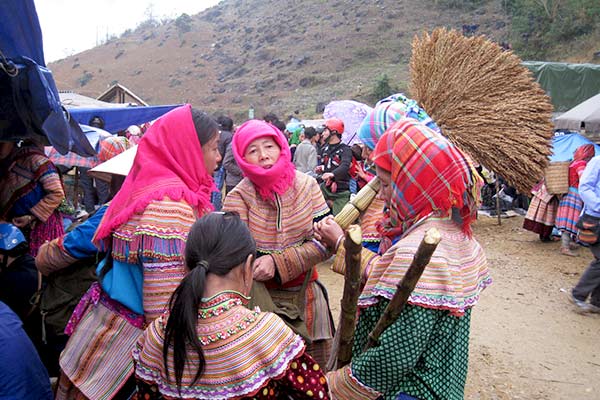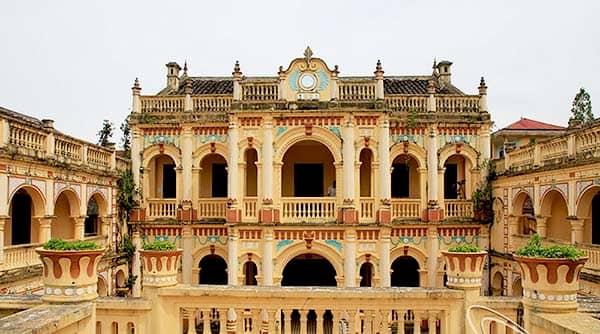BAC HA - NORTHERN VIETNAM
THE CAPITAL OF THE HMONG FLOWERS
The majestic landscape of Bac Ha, a city in Northern Vietnam, is just as fascinating as that of its neighbour Sapa, but the peaceful city still escapes the excessive development of tourism and manages to preserve its authenticity.
The city is located in the middle of high mountains, rice fields and every week is held one of the largest ethnic minority markets in the region and Northern Vietnam.
In
addition to the weekly markets, Bac Ha offers fantastic trekking opportunities.
The immense mountains are dotted with tiny minority villages and breathtaking
views.
Bac Ha Market
The Bac Ha market is a magnet for local mountain tribesmen, especially for the Hmong flower. If you can, spend the night in Bac Ha on Saturday and arrive there early before the travellers who stay in Sapa.
Every Sunday morning, when the sun rises on the mountains, hundreds of inhabitants of the Dao Noir, Hmong, Tay, Nung, La Chi and other ethnic minorities flock to the market, creating an explosion of colour in the green valley. The atmosphere of the market is lively and welcoming, attracting crowds to a colourful bazaar that will be one of the strong memories of your trip to Vietnam.
Hmong flower women wear several layers of dazzling clothing. These include a collar shawl, a refined collar and an apron style garment; both are made of narrowly woven multicoloured fabric strips, often with a frilly border. Highly decorated ankle cuffs and fabrics are also part of their costume, as well as a checkered scarf (often pink or green in colour).

Bac Ha Market
Tourist
products, on the other hand, include brocade, collars and cuffs, earmuffs,
scarves and other wearable items. You will also see Hmong batik skirts and beautifully
embroidered hats for children. There are many blankets, wall hangings,
trimmings and leftover fabric, which can be framed or reused for something new.
If you search, you will also find other nice souvenirs, including old bells for
cows and buffaloes.
Other markets in the Bac Ha region
Can
Cau Market (6am-1pm on Saturday)
This
Saturday market, located 20 km north of Bac Ha, attracts a growing number of
visitors. Some visits to Sapa now pass through Can Cau on Saturdays before
moving to Bac Ha for the Sunday market. Some merchants from Bac Ha also go to
Can Cau on Saturdays. It is still a magnet for local tribes, including the
flower Hmong and blue Hmong. The market overflows onto a hill with food and
livestock stands at the bottom of the valley, including many dogs. The
inhabitants will beg you to drink the local alcohol with them. Some trips to
Can Cau include the option of an afternoon trek to the nearby village of Fu La.
Coc
Ly Market (8h30-13h30 on Tuesday)
The
impressive Coc Ly market attracts the Dao, Hmong flower, Tay and Nung peoples
from the surrounding hills. It is about 35 km southwest of Bac Ha on relatively
good roads. Travellers from Bac Ha can organize day trips.
Lung
Phin Market (6am-1pm on Sundays)
The
Lung Phin market is located between the Can Cau and Bac Ha markets, about 12 km
from the city. It is less crowded than other markets and has a very local
atmosphere.
Sin
Cheng Market (5am-2pm on Wednesdays)
This market, located in the remote border region of Si Ma Cai, 40 km from Bac Ha, is a vibrant and chaotic weekly centre for the Nung and Thu Lao ethnic minorities living in the surrounding villages.

Hoang A Tuong Palace in Sapa
Other places to visit in Bac Ha
The
Fairy Cave
The
blue and cold waters of the Chay River, surrounded by cavernous rocks, seem to
be a scene from your childhood fable and will immediately transport you to a
quiet atmosphere. It is necessary to row upstream from the river before
reaching the pristine beauty of this destination. The caves themselves are
quite fascinating, with their unique cuts and crevices designed by the very
movement of the water they facilitate.
Hoang
A Tuong Palace
Located on the outskirts of Bac Ha, this palace is a living example of French colonial architecture with Chinese reflections. The interior of the house is a labyrinth of finely decorated pillars, decorated walls and vestibules that were centres of family activities. The building is a two-storey structure and the view from the top is appealing.
This
palace, also known as the "Hmong Kings' Palace", was started in 1914
and completed in 1921. Hoang Yen Chao, the chief of Bac Ha territory until 1950
and his son Hoang A Tuong, of the Tay ethnic group, were the owners of this
imposing structure.



